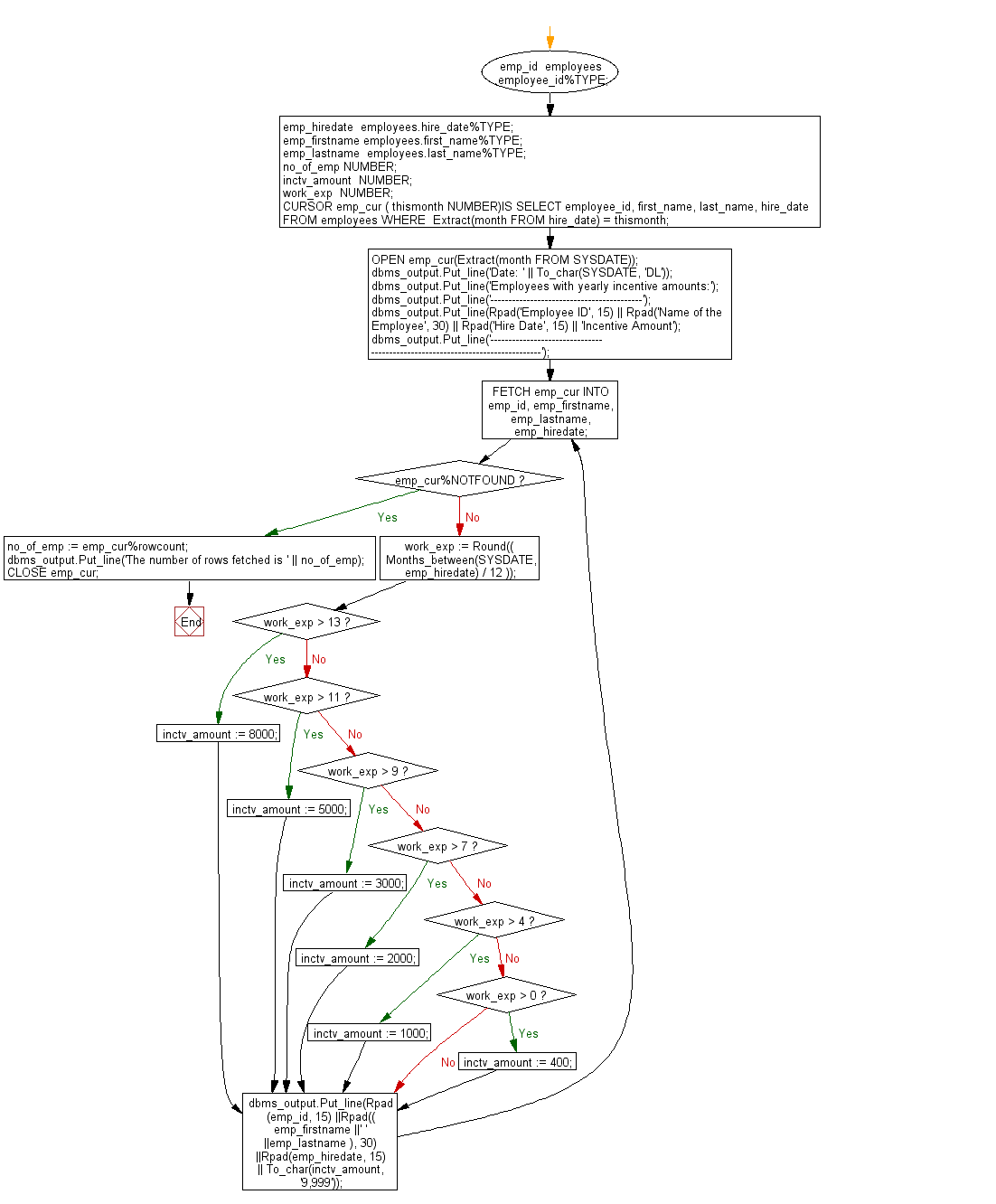PL/SQL Cursor Exercises: Print a report which shows that, the employee id, name, hire date, and the incentive amount they achieved according to their working experiences
PL/SQL Cursor: Exercise-47 with Solution
Write a block in PL/SQL to print a report which shows that, the employee id, name, hire date, and the incentive amount they achieved according to their working experiences, who joined in the month of current date.
Sample Solution:
Table: employees
employee_id integer first_name varchar(25) last_name varchar(25) email archar(25) phone_number varchar(15) hire_date date job_id varchar(25) salary integer commission_pct decimal(5,2) manager_id integer department_id integer
PL/SQL Code:
DECLARE
emp_id employees.employee_id%TYPE;
emp_hiredate employees.hire_date%TYPE;
emp_firstname employees.first_name%TYPE;
emp_lastname employees.last_name%TYPE;
no_of_emp NUMBER;
inctv_amount NUMBER;
work_exp NUMBER;
CURSOR emp_cur (
thismonth NUMBER)IS
SELECT employee_id,
first_name,
last_name,
hire_date
FROM employees
WHERE Extract(month FROM hire_date) = thismonth;
BEGIN
OPEN emp_cur(Extract(month FROM SYSDATE));
dbms_output.Put_line('Date: '
|| To_char(SYSDATE, 'DL'));
dbms_output.Put_line('Employees with yearly incentive amounts:');
dbms_output.Put_line('------------------------------------------');
dbms_output.Put_line(Rpad('Employee ID', 15)
|| Rpad('Name of the Employee', 30)
|| Rpad('Hire Date', 15)
|| 'Incentive Amount');
dbms_output.Put_line('------------------------------------------------------------------------------');
LOOP
FETCH emp_cur INTO emp_id, emp_firstname, emp_lastname, emp_hiredate;
EXIT WHEN emp_cur%NOTFOUND;
work_exp := Round(( Months_between(SYSDATE, emp_hiredate) / 12 ));
IF work_exp > 13 THEN
inctv_amount := 8000;
ELSIF work_exp > 11 THEN
inctv_amount := 5000;
ELSIF work_exp > 9 THEN
inctv_amount := 3000;
ELSIF work_exp > 7 THEN
inctv_amount := 2000;
ELSIF work_exp > 4 THEN
inctv_amount := 1000;
ELSIF work_exp > 0 THEN
inctv_amount := 400;
END IF;
dbms_output.Put_line(Rpad(emp_id, 15)
||Rpad(( emp_firstname
||' '
||emp_lastname ), 30)
||Rpad(emp_hiredate, 15)
|| To_char(inctv_amount, '9,999'));
END LOOP;
no_of_emp := emp_cur%rowcount;
dbms_output.Put_line('The number of rows fetched is '
|| no_of_emp);
CLOSE emp_cur;
END;
/
Sample Output:
SQL> / Date: Saturday, May 26, 2018 Employees with yearly incentive amounts: ------------------------------------------ Employee ID Name of the Employee Hire Date Incentive Amount ----------------------------------------------------------------------------- 104 Bruce Ernst 21-MAY-07 3,000 115 Alexander Khoo 18-MAY-03 8,000 122 Payam Kaufling 01-MAY-03 8,000 174 Ellen Abel 11-MAY-04 8,000 178 Kimberely Grant 24-MAY-07 3,000 197 Kevin Feeney 23-MAY-06 5,000 The number of rows fetched is 6 PL/SQL procedure successfully completed.
Flowchart:

Go to:
PREV : Write a block in PL/SQL to display the first department with more than five employees.
NEXT : Write a block in PL/SQL to shows how are records are declared and initialized.
Improve this sample solution and post your code through Disqus
What is the difficulty level of this exercise?
